Ryan came across a blog post by Jay Baer on a tool called Inbound Writer which is designed to help writers create better B2B content marketing pieces. Jay was so enthusiastic that Ryan gave it a go and Ryan, while considerably less enthusiastic, thought it might be worth playing with. So I’m creating this very blog post using the tool.
How does it work? Well, it’s my first time, but this is what it looks like to me:
— You tell it three keyphrases you want to write about – I used B2B Content Marketing, B2B Content Marketing Strategy and B2B Content Marketing Tactics.
— It goes off and does natural language analysis of lots of websites and social streams that are related to these three terms.
– It then drops you into a dashboard with some cool-looking features:
In the middle is the panel where you write your post. I’m writing in it now.
On the right is a list of 118 relevant terms that “your audience is using when discussing your topic”.
For me, this list was a bit weird before I started typing (SEO figured high up; But, on the plus side, the term “Velocity Partners” appeared, which is gratifying as we’re certainly all about B2B content marketing strategy) (see what I did there?).
The cool thing: as you type, this list changes, and the terms I’m actually using in my blog post start to float to the the surface. For instance, at this moment, the list looks like this:
But before I started typing, it looked totally different, with terms like Search Engine Optimization on top.
Above this list is a panel for Focus Terms – the ones that have been emphasized in my blog post. None are here yet, because I haven’t typed very much yet.
Here’s the interesting bit. In the upper left is a dial that shows my Document Score for this post. Right now, it scores this post as a 5 out of 100, which is not very good:
[I’ll update you with my changing Document Score in square brackets as I go on.]
Below the Document Score dial is a box for suggestions on “Steps to Improve My Score” which reads, at this very moment: “Your document doesn’t include the right number of Focus Terms” (not a crime as none have appeared in that box yet) and “Shorten your title”. Hmmm. Getting a bit bossy. (My title is ” Can dynamic SEO tools really boost traffic from B2B content marketing? ” but I can take a hint, so I’m changing it to “B2B Content Marketing: a writer’s SEO tool.”
[Ooh. I just shot up to a 36/100 and I haven’t even made the title change yet.]
Here goes, I’m going to make the title change…
[And I just shot up to a Document Score of 40/100.] I kind of like this!
It make me feel that I’m actually improving the SEO performance of the piece as I type.
The big question: will this kill the human-reader-value of the post?
Inbound Writer has a nice way of addressing this: below the improvement tips is a box that says “My Strategies” with “Search & Social” as one and “Reader Targeting” as the other. What this lets you do is set your strategy so the Document Score reflects your priorities, instead of some abstract notion of B2B Content Marketing strategy.
[Update: I just got penalised a point for some reason. I’m down to a 39/100].
For example, I set my Search & Social Strategy to ‘Balanced Strategy’ which means it’s balanced between search popularity and search competition:
And I set my Reader Targeting to “All Education Levels”. For what that’s worth.
What this doesn’t do is help you avoid writing a really crappy blog post artificially packed with blatant keyphrases like B2B Content Marketing Strategy. But if you were that way inclined, no tool will really help you.
So I’m about half way through this post. Has Inbound Writer helped me much? Not sure yet.
It’s certainly making me painfully aware that I have to use terms like B2B Content Marketing Strategy and B2B Content Marketing Tactics more than I might otherwise do. For this post, it’s okay, because the review format is letting me use these terms a lot without sounding like an SEO robot. But for a different kind of post, my human readability would suffer, I fear.
[Back up to 41/100 — two lousy points for that blatant keyphrase pimping??!]
I like playing with this tool but I’m not yet convinced it will work. Doesn’t Google hate this kind of keyphrase packing? Time will tell, I guess.
I just tried something. I included a list of keyhprases from the Relevant Terms list on the right and tried to make it seem natural. Result: I got a warning that said, “Improve your score by refining the focus of your document.” and it stuck me on 41/100.
So I deleted that.
[I have now used the term B2B Content Marketing six times and the term B2B Content Marketing Strategy six times each, including these ones. But I’m still on 41/100].
My robot advisor wants me to add another keyphrase to my Focus Terms list. It says that for a post of this length (865 words) I should have three Focus Terms. So now I have to get the term B2B Content Marketing Tactics into this post somehow. Two more times according to my live data.
Here goes: the nice thing about B2B Content Marketing Tactics is that they naturally emerge from your B2B Content Marketing Strategy. No. Sorry. I’m hating this. That last sentence is CRAP for human beings and I just refuse to write for a bloody algorithm.
Why? Because it’s just poor B2B Content Marketing tactics, that’s why. [Up to 42/100. Shooting for 60/100. Wish me luck]. I now have three Focus Terms in my list and my Improvements suggestion box simply says, “You may need to take additional measures to improve your score.” Intrigued, I click on the little arrow for more advice and get, “… the terms you are focusing on are not highly rated.” and a suggestion that I might want to choose another subject!
The nerve. I want to write about THIS subject. B2B Content Marketing is what we do! Why would I want traffic for a “highly rated” phrase like Web Content Management if we don’t DO Web Content Management!?
Annoying but somehow a perverse challenge. And I love a perverse challenge — the perverser the better. [43/100]
Here goes. I’m going to go for a 4.5-star term called “Content Development” which I can live with in this post. After all, you can’t do B2B content marketing without seriously considering your content development strategy.
Content development is indeed one of the major challenges in B2B content marketing, so I have no problem adding the term ‘content development’ into my blog post. [45/100 — I think I’m on to something here].
But is Content Development a 4.5-star term for the right reasons? Will it attract the kind of people I want to reach (B2B content marketers) or will it also rope in all those ‘media’ types who are always going on about ‘content’ by which they mean things like Madonna songs and Big Brother’s Little Brother, which, to me, are both content-free zones, but hey, I’m fifty.
My point is: this post may end up ranking well for Content Development but then attract all sorts of riff-raff. [51/100! We’re on the move!]. So the post may rank well but have a massive bounce rate when the media types show up and realise that this is about content development but not in the Big Brother’s Little Brother sense of the term.
Now my suggested improvements say, “Refine the focus of your document” (duh) and “Use a more highly ranked Focus Term in your title.”
So I am now changing the title of this post to “Content Development using Inbound Writer.” Let’s see if it buys be any points….
[Success! I hit 60/100. Dare I aim higher? I dare.]
Content Development is indeed a funny thing. Especially when your content development is being shamelessly distorted by some BLOODY ANNOYING SEO TOOL. Calm. Breathe.
I now have a blog post that’s all over the place.
Weirdly, that’s okay THIS TIME because this is actually a review of a content development tool called Inbound Writer. So the scattiness and wandering and keyphrase-packing is all kind of relevant to the content development task at hand. [Still 60/100].
It looks like the only thing I can do to improve my score is to abandon this post and start another post on Content Development. Maybe I’ll do that.
Conclusions:
— The jury is out. Writing for Google before the mythical B2B marketing reader in my head is really foreign to me. I don’t think it’s a good thing. I think it’s a bad thing.
Maybe this tool isn’t really designed for me, but for an “SEO copywriter” (a term and job title I instinctively don’t approve of).
– Putting that aside, the thing I’m not convinced by is the way the tool suggests terms for me. Shouldn’t you determine your best terms before you start? And shouldn’t they be RELATED TO WHAT YOU ACTUALLY DO instead of simply relating to a juicy term that’s under-competed?
– But if you’ve got your keyphrases sorted, and can live with a mediocre Document Score (limited by the popularity of your chosen terms) then Inbound Writer might help you keep your eyes on the prize as you write.
Bottom line: I’m still suspicious but I may give it a few goes before making up my mind. Now for that post all about Content Development…
My final score:
And the Focus Term usage panel:
——————————–
UPDATE
After the response from the Inbound Writer team (see my comment below), I felt I’d been a bit hasty in my review. So I went back to use Inbound Writer again, this time for a straightforward blog post called Content Development: Nine Tips for B2B Marketers.
My experience? A bit better than my first go, which was kind of distorted by combining a post with a review of the tool I was posting with.
The Inbound Writer robot gave me a similar set of tips to improve my score (which started with a whopping 78, dipped into the 60s then ended up as a 70).
The robot kept suggesting I focus on terms that had more search action, like Marketing Strategy. I’m still dubious about writing to a topic that is so broad – it might get more traffic but would also get a massive bounce rate.
I used the Focus Terms a hell of a lot in this post, which upped my score but may have damaged my human readability a bit:
Bottom line?
I feel like I’m pretty SEO-aware as I write blog posts, so I’m not really sure this tool will help me that much.
But I can see its value as a short cut for writers new to a market who haven’t done a comprehensive keyphrase analysis and don’t have time for one. In that scenario, Inbound Writer could help find good keyphrases and remind the writer to optimise around them.

Enjoyed this article?
Take part in the discussion



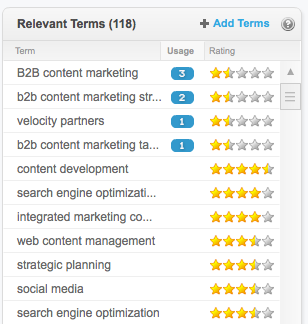
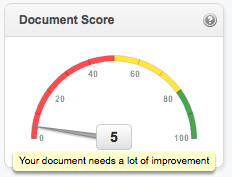
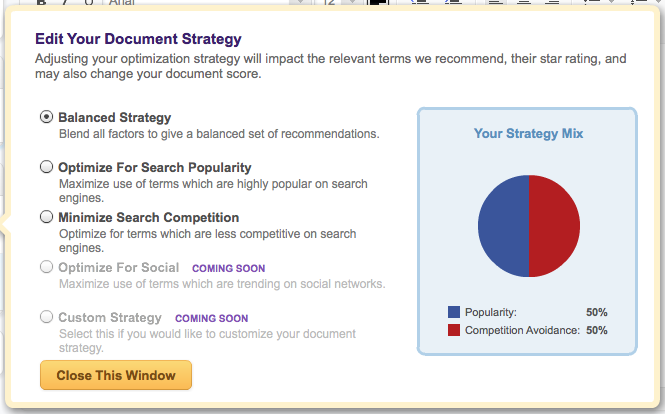
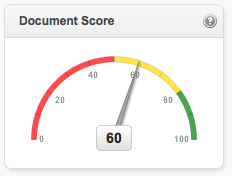
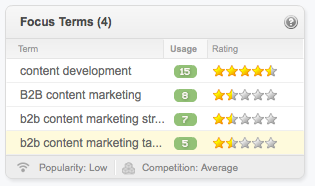
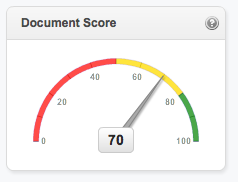
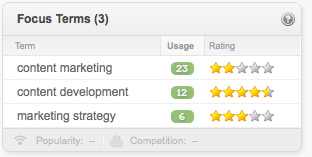





Comments
Ryan Skinner October 12th, 2011
Doug, you are without a doubt the Chuck Yeager of real-time SEO writing. What did he say? Something like “Do what scares you, then go even further”.
Somewhere, someone is cranking out a string of posts that break into that +80 green territory – where even SEO angels fear to tread.
Katharine Tylko October 12th, 2011
Doug – I’m worried about your mental health. You need to get out more!
Mark McClure October 16th, 2011
Haha! But where’s the tool that’ll spin 25 unique versions of said post?
Doug Kessler October 18th, 2011
UPDATE
After writing this review, three nice things happened:
1) I got an email that said:
Hi,
Thanks for using InboundWriter! We noticed you got a score of 60.0 on your last document titled “Content Development using Inbound Writer” and we wanted to help.
Click the button below to have your document reviewed by an InboundWriter expert. After one of our experts has reviewed your document, you will receive an email with details on what they did to improve your score. This has proven to be a very effective way to get users comfortable with InboundWriter so we hope you will take advantage of this great service.”
Of course, I was curious so I submitted my review for review.
2) Then I got this from a real human named Jay McCarthy:
“Greetings,
Thank you for using InboundWriter and requesting a review of the document titled “Content Development using Inbound Writer”. Here’s my observations:
It looks like you’ve done a pretty good job of following the tips provided along the way. It appears that the only thing keeping you from achieving a higher score is the ranking of the terms you have chosen to emphasize.
These terms are fine but just not heavily searched for by potential readers. If you are able to find a four or five star terms which are on topic and can be emphasized then your chances of obtaining additional visitors is greater by using them instead.
This of course presumes that the intent of your writing is not lost and you still feel that it flows naturally. There’s of course a fine line between choosing terms which are more heavily searched and trying to fit terms which do not add value to the reader.
In the end you may be happy to accept the terms which have a lower score and accept the reduction in potential reach of the document.
Some of the other terms such as “search engine marketing” or “search engine optimization” or perhaps “Inbound Marketing” may be appropriate for an article on InboundWriter for instance.
In the end it’s up to you, as the most important thing is to be informed and write good content.
Thank you again for using InboundWriter. By the way if you have any thoughts about how InboundWriter can be less obtrusive and yet provide guidance on best practices I’m keen on getting your thoughts. It’s a fairly new product and we’re always looking for ways to improve it.
Thanks again for using InboundWriter.
Regards,
Jay McCarthy
Chief Product Evangelist”
Those feel like really good suggestions to me.
Jay put aside the fact that the review was all about his company and delivered what they promised: an honest appraisal of the piece, with recos.
He then invited me to give my views directly to them.
And of course, Jay has a point: if I’m reviewing Inbound Writer, than the term SEO is supremely relevant, even if I wanted to write about content marketing.
So while I had fun teasing the IW robot for being a keyphrase-crammer, the robot actually had a point. Embarrassingly, the keyphrase-crammer turned out to be me.
3) I got a tweet from Inbound Writer that said:
“@dougkessler tx for the real-time review … would you have time for an online demo to explain a little more and get your feedback?”
An excellent example of social-media-powered customer support.
I do intend to go back and try Inbound Writer for another post.
If I do, I’ll report back.
Meanwhile, does anyone out there have any experience with it?